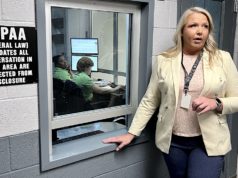
Last week, Oklahoma County District Attorney David Prater announced his findings on two Oklahoma City Police Department officers who shot and killed people in the line of duty. One officer was charged with murder, and one officer was cleared of wrongdoing. Neither officer, however, was wearing a body camera at the time of the shooting. But other police on scene were wearing cameras, highlighting a puzzling problem that needs a quick solution.
“I would love for every police officer on the street, whether it’s in Oklahoma City or anywhere else in this country, to wear body cams and have a dash cam in their car,” Prater told media Friday. “But that’s really for the police department to address.”
Unfortunately for Oklahoma City residents, the police department has failed to address the issue in a timely manner.
The OKCPD and the OKC chapter of the Fraternal Order of Police spent much of 2016 delaying the implementation of body cameras by bickering over policies. In November 2016, the two sides reached an agreement, but the purpose of the program remains unfulfilled more than a year later owing to insufficient excuses.
‘We’re purchasing more’
Asked about body camera statistics Friday after Prater’s press conference, OKCPD Cpt. Bo Mathews was unsure exactly how many body cameras the department possesses, but he estimated about 100. He did note the department would only need about 300 cameras to equip OKC’s 1,050 officers owing to shift scheduling.
But why has OKCPD been unable to procure and implement a full fleet of 300 cameras during the past year? That remains unclear, especially as Mathews blamed the delay on financial challenges.
“We’re purchasing more,” he said. “We’re getting more funding for them.”
That answer is puzzling since OKCPD itself sent out a press release Nov. 29, 2016, that noted it was using only 100 cameras. The release concluded with a sentence proclaiming a path forward toward equipping all officers: “The Police Department recently received a federal grant for $270,000 that will add 180 cameras to complete the program.”
Has that grant been delayed? Has a painfully slow supplier fumbled the order? Has the department dragged its feet for reasons of politics? Reasons of bureaucracy? Reasons of incompetence?
The public is left to wonder, discomforted by the notion that neither of the two recent OKCPD officers investigated for killing people was wearing a body camera. Where did that $270,000 of taxpayer money go?
31 million reasons
To that end, local taxpayers have even more reason to be frustrated by this body camera delay: 31,000,000 of them, to be exact.
In July, OKC voters approved almost $31 million in public revenue for the police department, including $3.96 million for a new hanger and aviation center, and $23.8 million for construction of a new police training center.
To pitch the vote on those two projects, city leaders described the situation on OKC.gov bluntly: “Police officers don’t have enough space for training. A new Police and Fire Training Center will provide more space for classrooms and exercises, providing better training for the life-saving services our residents need.”
Placed in a line of logic, the City of Oklahoma City’s argument boiled down to this: Please approve $31 million in tax dollars because our officers are not receiving adequate training; please don’t question why we have not spent the roughly $300,000 needed to equip our inadequately trained officers with body cameras to make sure they can be held accountable for their actions.
That’s a messaging nightmare and an utter failure from OKCPD leadership.
Enough is enough
The fact that OKCPD still lacks body cameras for every active patrol officer is inexcusable. This failure sends a message to citizens that neither the department nor the union care about holding officers accountable for their actions.
Chief Bill Citty and FOP president John George should be ashamed of this shortcoming and frustrated by the damage their incompetence on this issue does to public perception. Every day that passes without all on-duty officers outfitted in body cameras bolsters arguments that the public can trust neither its police department nor the union representing officers.
While we believe in the OKCPD’s intentions and see a vast majority of its officers doing dangerous work professionally and positively, the department’s extended inability to equip more than one-third of its officers with a body camera continues to erode public trust. Action should be taken before the end of 2017 to expand OKCPD’s body camera program and meet its stated goal without excuses.




















